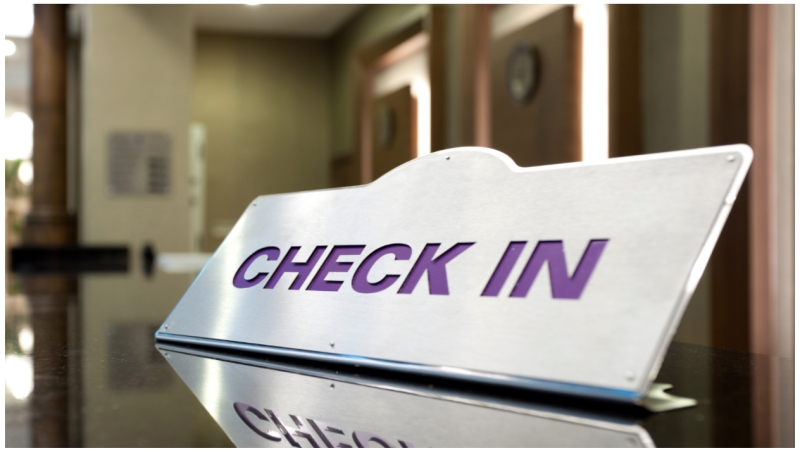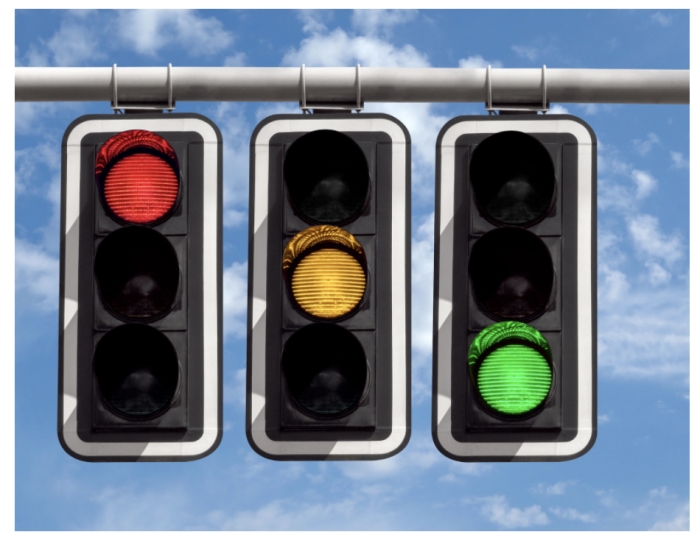How often do you pause and ask yourself, “How am I doing today?”

Chances are, you’re too busy and preoccupied to really check in with yourself. Today’s world is fast-paced and doesn’t allow much time to pause and reflect. And when you don’t regularly make room in your hectic life to examine how you’re doing you’re likely to find yourself experiencing high anxiety levels.
But how exactly do you check in with yourself? Do you really know? It’s actually easier (and less time-consuming) than you think.
Your Baseline Anxiety Level
Anxiety is a healthy physiological response that occurs in your body. It’s perfectly natural. You experience anxiety of some sort every single day.
But each and every one of us has a baseline anxiety level, and it’s different for everyone. Your body recognizes your particular baseline anxiety level. So when you begin experiencing anxiety above that baseline, your body will let you know.
What Leads to Higher Anxiety Levels

You’ll often experience increased anxiety symptoms when unpleasant memories arise. These uncomfortable and sometimes traumatizing recollections live within your conscious and unconscious mind.
Different situations can trigger these memories and raise anxiety levels on a daily basis. For example, a conflict with someone you care about or being reminded of traumatic events can increase anxiety symptoms.
If you feel like you experience higher anxiety levels regularly, you need to address them. If not, your normal stress responses become more heightened. In turn, this leads to living in discomfort every single day.
Some of the everyday stress responses that come with higher anxiety levels include:
- Headaches
- Fatigue
- Digestive discomfort
- Muscle tension
- Accelerated heart rate and breathing
- Temporary hair loss
High levels of anxiety can make life uncomfortable. And if you deal with anxiety at a high level every day, you may begin using maladaptive defense mechanisms to cope.
Understanding Anxiety: What It Is And What You Need To Know About It
These can include, but are not limited to:
- Numbing: Most of us use numbing as a coping skill on a regular basis, whether it’s through overeating, alcohol or drugs, over-exercise or “zoning out” while binge watching shows. This allows us to numb and distract from our anxiety, but can lead to consequences when we avoid reality too often or use drugs or alcohol in a way that causes real-life consequences.
- Worrying: Thinking through a problem once or twice is helpful, but thinking about it over and over isn’t–it’s more like torture for our brains. When anxiety leads to using worrying (also called “ruminating” or “perseverating”) as a coping skill, it can interfere with our ability to be present in daily life and cause insomnia.
- Discharge: Getting irritable, snapping, yelling, even swearing is a way to “discharge” our anxiety and can bring short-lasting relief, but often ends up causing more discomfort when the guilt and regret set in about what we’ve done.
- Denial: You refuse to admit or recognize something is “wrong.” People struggling with addiction often deny they have a “problem,” and people stuck in toxic relationships deny that there is anything wrong with their partner or them. Denial protects your ego from things when you simply can’t cope with your high anxiety levels.
- Projection: This happens when you take your unwanted feelings and put them on others. It works by allowing you to experience the emotion or feeling but not in a way your ego can recognize it.
- Displacement: Sometimes, as a defense mechanism to deal with anxiety, you’ll take out your frustrations, anger, and resentment on undeserving parties.
For example, if you’re stressed at work and can’t necessarily express your anger and frustration, you may come home and take it out on your family.
- Rationalization: Rather than dealing with difficult news or situations that cause high anxiety levels, you may resort to rationalization.
This is the act of explaining the unwanted or unacceptable behavior rationally or logically, rather than facing the anxiety it may induce. (“I can’t be angry at him because he didn’t mean to forget to make dinner.”) But regardless of the reason, the feelings are still there.
When you use some of the above coping mechanisms to deal with anxiety, they can become destructive to yourself, your relationships, and your life. That’s why it’s critical to regularly check in with yourself, no matter how challenging it may be.
Reading Your Body’s Anxiety Symptoms
Your body constantly gives you physiological signals to pinpoint your anxiety levels. But you must check in with yourself to find them. There is a lot of power and courage in becoming better aware of your anxiety when it shows up.
To better recognize your level of anxiety, think of it as occurring in your body in one of three colors of a traffic light.
Types Of Anxiety Disorders And The Best Anxiety Treatment Options
Red Anxiety Level
When you are experiencing high anxiety levels, you’re at a red level. Here, your body and mind signal that there is a significant disruption in our cognitive (thinking) and perceptual (sensory) abilities.
Your response to conflict at this phase may be irrational because of the substantial disruption in your cognitive ability.
Some red level anxiety symptoms to look for:
- Blurred vision
- Inability to concentrate
- Lightheadedness
- Dizziness
- Going “blank”

Yellow Anxiety Level
At a slightly lower anxiety level, your body signals to you through smooth muscle (involuntary muscle) anxiety symptoms. You may be able to respond to conflict more rationally than in the “red” zone, but it can still be challenging to think through your responses healthily.
Some yellow anxiety level symptoms to check for:
- Gastrointestinal discomfort (nausea, diarrhea)
- Bladder: urge to urinate
- Migraines
- High blood pressure
- Feeling jittery
Green Anxiety Level
At this level, you’ll experience the most common anxiety symptoms. Your body signals to you through striated (voluntary) muscle reactions.
When you check in with yourself and find you can make rational decisions and think clearly despite relative discomfort, you are experiencing green level anxiety symptoms.
Some green level anxiety symptoms to check for:
- Bodily muscle tension in your arms, neck, or shoulders
- Tight stomach muscles
- Fidgeting
- Clenching your hands
- Tension headaches
What Happens When You Find Your Anxiety Level Over Your Baseline
Because you experience anxiety daily, you’ll have days where you deal with anxiety above or below that line.
For example, perhaps on a typical workday, you experience striated muscle symptoms (green) with mild bodily tension due to an upcoming work deadline. As a result, you also feel other anxiety symptoms like tension headaches and tight muscle sensations.
But when a co-worker becomes verbally aggressive, you’re reminded of an unpleasant situation from your past. In this case, your anxiety level would go over its normal baseline. As a result, you may find yourself experiencing cognitive, perceptual disruption (red) symptoms. You may dissociate at meetings, find it difficult to concentrate, or go blank and lose track of your thoughts.
4 Easy Grounding Techniques for Anxiety
When you significantly go above your anxiety baseline level, you may appear normal to the people around you while experiencing high cognitive disruption. When you find yourself in this state, it’s usually challenging to do your regular daily tasks.
But if you can check in with yourself, the physical sensations you experience will clue you in to identify your anxiety level. And if you can locate your anxiety level, you can avoid responding with unhelpful defenses.
Where to Go to Get Quality Anxiety Treatment in San Diego
How to Deal With Anxiety

Next time you’re feeling anxious, check in with yourself through the traffic light phases of anxiety. Once you pinpoint your anxiety level, you can do several things to deal with anxiety.
Depending on your anxiety level and frequency, one excellent thing you can do is practice breathing exercises. One of our favorites, which can be done anywhere, is the Square Breathing method. While it may feel unnatural, as many breathing exercises do, it’s a helpful way to deal with anxiety.
Another beneficial tool in managing your anxiety symptoms is a qualified, experienced therapist. Here at BOLD Health, our comprehensive team of mental health experts is ready to help you manage and deal with your anxiety in positive ways.
Our BOLD method means we only use science-backed approaches to facing and overcoming mental health concerns like anxiety. Whether you need individual therapy, group therapy, medication management, or even an intensive outpatient program (IOP), we’ve got it all.

For the best anxiety treatment in San Diego, contact us. We’re ready to teach you how to effectively check in with yourself and deal with anxiety in healthy ways.
The article was written by: Feji Etibo, MA, AMFT


[…] How to Check-In With Yourself and Your Anxiety […]
[…] How to Check-In With Yourself and Your Anxiety […]
[…] you’re not alone. Countless friends, family members, and neighbors regularly experience stress and anxiety. It’s embedded in our society, directly linked to the fast-paced nature of the United States. That […]